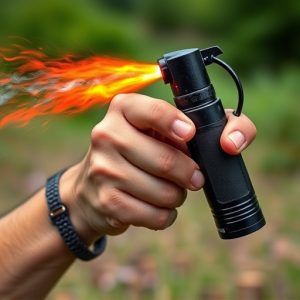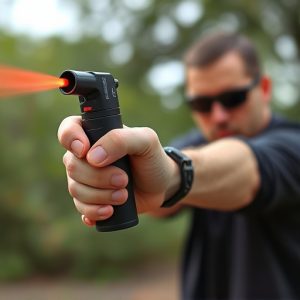Pepper Spray Defense: Optimal Storage & Performance Secrets Revealed
Maintaining tactical inflammatory spray (pepper spray) within an optimal storage temperature range o…….
Maintaining tactical inflammatory spray (pepper spray) within an optimal storage temperature range of 50°F to 70°F (10°C to 21°C) ensures its potency, effectiveness, and longevity. Extreme heat or cold can degrade the active ingredient capsaicin, while high humidity levels should be avoided to prevent moisture buildup inside the canister. Storing pepper spray in a cool, dry place, shielded from direct sunlight, minimizes degradation and reduces the risk of accidental discharge due to temperature-induced physical changes. Adhering to these guidelines maximizes the spray's reliability as a self-defense system when needed.
“Tactical inflammatory spray, a powerful self-defense tool, has gained prominence in personal safety. This comprehensive guide explores the intricate world of pepper spray technology. We delve into its mechanisms, uncovering the science behind its effectiveness and how environmental conditions, especially optimal storage temperature, significantly impact performance. From understanding its operation to best practices for storage, this article equips readers with vital knowledge on maximizing the efficacy of tactical inflammatory spray, ensuring its reliability when it matters most.”
- Understanding Tactical Inflammatory Spray: A Comprehensive Overview
- The Science Behind Pepper Spray's Effectiveness
- Environmental Factors: Impact on Storage and Performance
- Best Practices for Storing Tactical Inflammatory Spray
- Optimal Storage Temperature: Ensuring Maximum Efficacy
Understanding Tactical Inflammatory Spray: A Comprehensive Overview
Tactical inflammatory spray, commonly known as pepper spray, is a non-lethal self-defense agent that has become a staple in personal safety strategies. It works by causing a temporary yet intense irritation to the eyes and respiratory system, allowing the user to create a safe distance from potential threats. The active ingredient in most tactical sprays is capsaicin, derived from chili peppers, which triggers a painful reaction when it comes into contact with sensitive areas of the body.
Understanding the optimal best storage temperature for pepper spray is crucial to ensure its effectiveness and longevity. Pepper spray should be stored in a cool, dry place, typically between 50°F and 70°F (10°C to 21°C). Exposing it to extreme temperatures can cause the chemical composition to degrade, reducing its impact. Proper storage also prevents accidental discharge due to temperature-induced expansion or contraction of the canister. By adhering to the recommended storage guidelines, users can maximize the spray’s potency and ensure they have a reliable defense system when needed.
The Science Behind Pepper Spray's Effectiveness
Pepper spray, a tactical defensive tool, relies on capsaicin, the active ingredient found in chili peppers, to disrupt an attacker’s vision and breathing. This chemical irritant causes a burning sensation in the eyes and nasal passages, temporarily incapacitating the target. The effectiveness of pepper spray lies in its ability to create a rapid and powerful response, allowing users to gain time and distance from a potential threat.
Proper storage is paramount for maintaining pepper spray’s potency. Recommended at temperatures between 50-70°F (10-21°C), ideal storage conditions ensure the chemical remains active. Extreme heat or cold can degrade the capsaicin, reducing the spray’s effectiveness. Thus, storing pepper spray in a cool, dry place, away from direct sunlight, is essential to maximize its utility when needed.
Environmental Factors: Impact on Storage and Performance
The environmental conditions in which tactical inflammatory spray is stored can significantly impact its performance and shelf life. One of the most critical factors is temperature, particularly the best storage temperature for pepper spray. It’s recommended to keep these defensive tools in a cool, dry place, with ideal storage temperatures ranging between 50-70°F (10-21°C). Extreme heat or cold can cause the chemical composition of the spray to degrade, reducing its effectiveness and potentially affecting the timing and intensity of its impact.
Humidity is another environmental consideration. High humidity levels can lead to moisture buildup inside the spray canister, which may result in decreased performance or even corrosion. It’s advisable to store tactical inflammatory sprays in areas with controlled humidity to maintain their optimal condition. Proper storage conditions ensure that when the need arises, these defensive systems operate reliably, providing the intended level of protection and deterrence.
Best Practices for Storing Tactical Inflammatory Spray
Storing tactical inflammatory spray, or pepper spray, requires careful consideration to maintain its effectiveness and safety. The ideal best storage temperature for pepper spray is between 50°F and 80°F (10°C to 27°C). Temperatures outside this range can degrade the spray’s potency over time. Extreme heat can cause chemical reactions that diminish the active ingredients, while cold temperatures may result in freezing, impacting the spray’s pressure and release mechanism.
In terms of handling, it’s crucial to keep pepper spray out of direct sunlight and away from sources of heat or open flames. Store it in a cool, dry place, preferably locked away, to prevent unauthorized access. Additionally, ensure that the storage area is secure and protected from potential contaminants, as these measures will help preserve the integrity of your tactical defense system.
Optimal Storage Temperature: Ensuring Maximum Efficacy
Maintaining the optimal storage temperature is crucial for maximizing the efficacy and lifespan of tactical inflammatory spray systems, commonly known as pepper spray. The best storage temperature for pepper spray typically ranges between 50°F to 70°F (10°C to 21°C). This range ensures that the active ingredients in the spray remain potent while preserving the overall integrity of the product.
Storing pepper spray outside this recommended temperature range can lead to premature degradation, reduced effectiveness, and even potential loss of chemical properties. Extreme heat or cold can cause the spray’s formula to become unstable, impacting its performance when needed most. Therefore, it’s essential to keep tactical inflammatory spray systems in a controlled environment that maintains consistent temperatures within the suggested range to guarantee optimal performance when deployed.
Tactical inflammatory spray, or pepper spray, is a powerful tool designed for self-defense. Understanding its science, environmental considerations, and best practices for storage, such as maintaining the optimal storage temperature, are key to ensuring its effectiveness. By adhering to these guidelines, users can maximize the efficacy of their pepper spray, providing them with a reliable means of protection in various situations. The ideal best storage temperature for pepper spray is crucial for preserving its potency and readiness when needed most.


